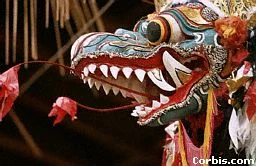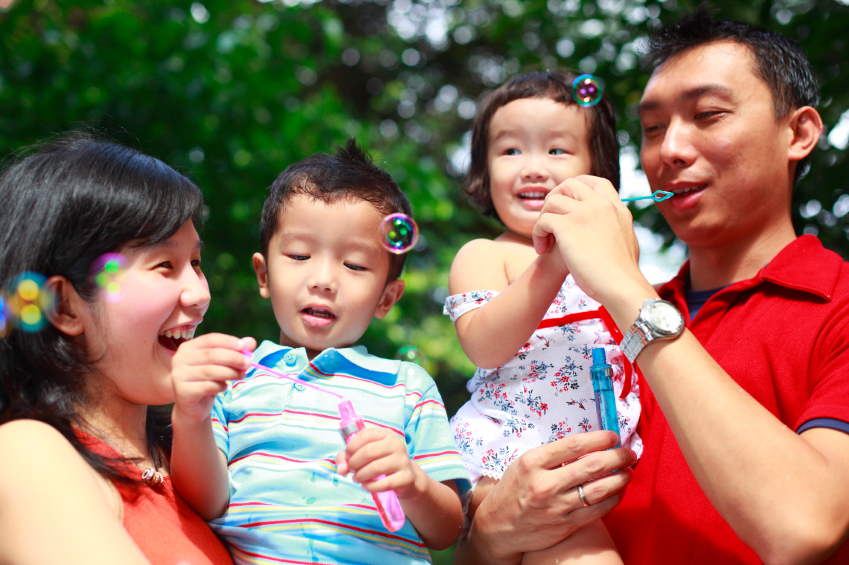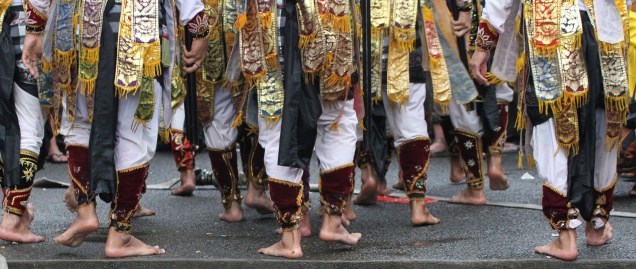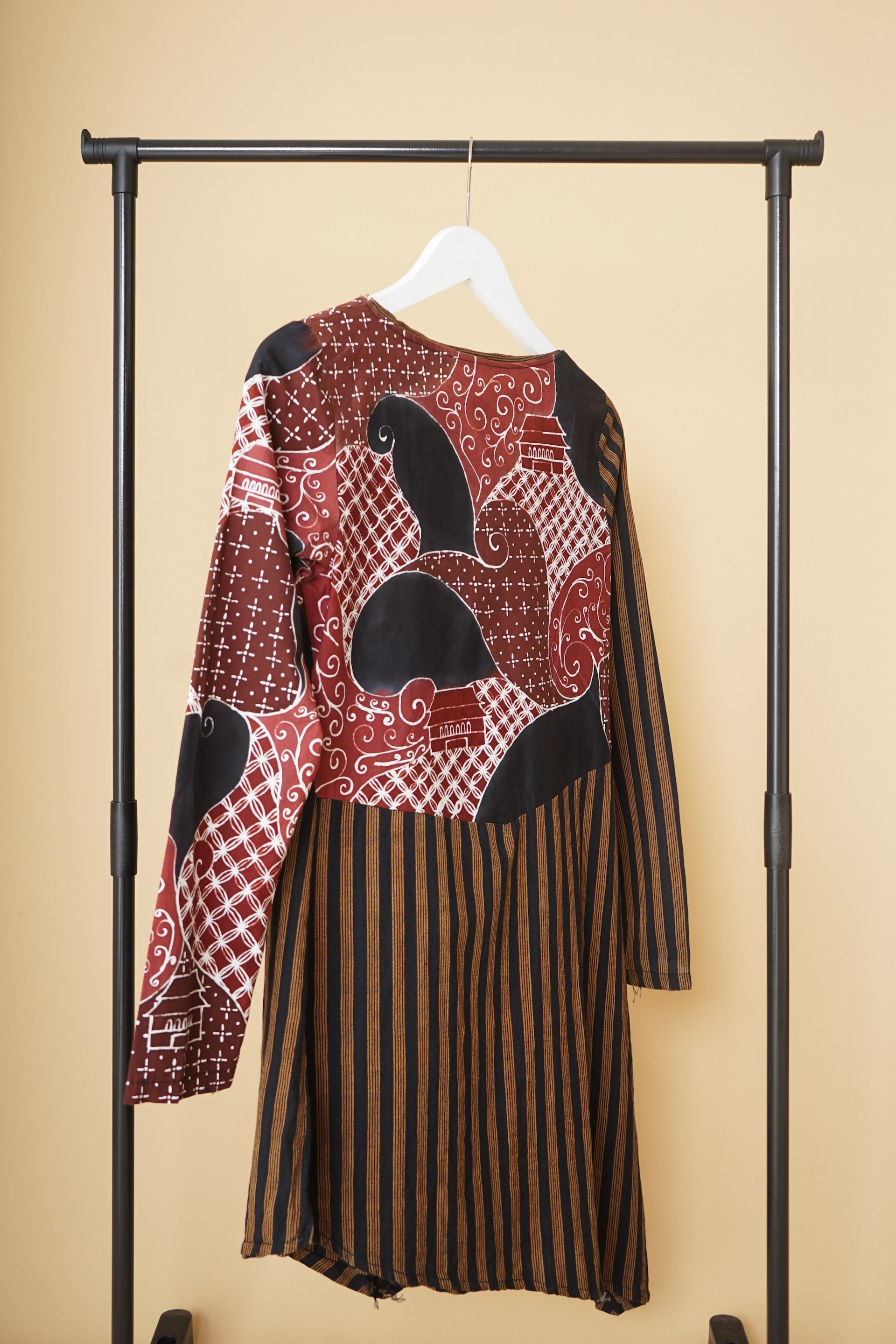There are lots of different kinds of clothing styles.
In Indonesia there are 300 groups of people with their own kinds of costume.
These costumes are worn on special occasions such as festivals and weddings
The weather is hot, so most clothing is loose fitting.
Sometimes fabric is decorated by embroidery or dyeing.
A great variety of clothing styles
Balinese traditional dress ©Getty Images
Traditional clothing styles are those that have been worn for decades or centuries. Because Indonesia is made up of so many islands, there is a variety of traditional clothing styles. There are about 300 ethnic groups in Indonesia and each has its own traditional costume. However, traditional costume is mainly worn on special occasions such as festivals, weddings, religious occasions and so on.
The climate is hot, so most clothing styles are loose, such as wrap-around sarong style skirts with over shirts of light fabric.
Modern day dress
Most Indonesians wear 'western' style clothing for everyday wear. Men wear pants and shirts, sometimes with a tie. Women generally wear dresses or skirts and blouses. Indonesian clothing is light in weight because of the hot and humid climate. Young people wear casual clothes like jeans and T-shirts.
Many people choose western style dress as everyday clothing.© iStock image
Sarongs on men
Indonesian men generally wore sarongs (usually with a checkered pattern) in the home. In public, the sarong is worn only when attending Friday prayers at the mosque. For formal national occasions, the men wear batik shirts with trousers or teluk beskap, a combination of the Javanese jacket and sarong.
Male dancers wear traditional costumes for dance.© Getty Images
A kebaya for women
For formal occasions, Indonesian women wear the kebaya. A kebaya is an embroidered blouse worn with a batik sarong in bright colours.
The kebaya is formal dress for many Indonesian women ©Getty
They may drape a long stretch of cloth, called selendang, over one shoulder. This cloth can be used as a head shawl.
Women are not required to wear traditional Muslim clothes but they tend to dress conservatively because there is such a large Muslim population. Very brief clothing is worn only on the beaches.
Read more about kebaya and see pictures:
http://www.expat.or.id/info/kebayatraditionaldress.html
Batik: an ancient art
Batik is a traditional fabric dyeing process that uses a technique called wax resist.
Indonesian craft workers have been making batik for over 1000 years. The process was first used by the people who lived on Java.
A worker applying hot wax onto cloth using a canting like a pen loaded with melted wax.
Image Mahmur Maganti on Unsplash
Batik is made when a pattern of hot wax is applied onto cloth, traditionally cotton. After the designs are applied with wax, the cloth is dipped into dye. The dye colours the parts of the material that are not waxed. The wax-coated areas resist colouring. The wax is removed by boiling the cloth. Wax is applied several times, so that the design can be in many different colours.
Traditionally, wax was applied with a tool called a canting, (say: ch-aunt-ing) which is rather like a wax-filled pen. Later, a copper stamp called a cap (say: chup) was invented, so that designs could be applied more quickly. These days machines are used to apply wax liquid patterns.
Batik is also used for modern fashion garments.These designs are based on traditional ones. Image Ema Lalita on Unsplash
There are about 80 traditional Indonesian batik designs, many of which are symbolic and worn on special occasions, such as at a wedding, to bring good luck to the bride and groom. However, today other designs are also made and used in modern garments, and batik is used to pattern pictures to hang on walls.
Watch a video about making batik in the traditional hand-made manner:
School uniforms
School children in uniform. ©Getty
All kids going to school in Indonesia wear uniforms. All children must go to school for 9 years : six years at primary (elementary) school and three at a secondary school.
Traditional costumes are worn by Balinese dancers ©Getty Images
Religion in Indonesia
There are a number of different religions in Indonesia, but the main religion is Islam.
The Indonesian people are free to follow the religion of their choice. The Indonesian Constitution guarantees freedom of religion. However, the government only recognises six official religions: Islam, Protestantism, Catholicism, Hinduism, Buddhism and Confucianism.
In 1945 President Sukarno established five principles or the Pancasila, (say pan-car-SEE- lah) to guide Indonesians. The first of the five principles is for people to believe in one supreme God no matter which religion a person belongs to.
In the 2010 Indonesian census, about 87% of Indonesians identified themselves as Muslim, about 9% Christian (Protestant or Catholic), about 3% Hindu, and nearly 1% Buddhist.
Islam
Islam has the most followers in Indonesia. This Muslim man is praying. © iStock
In Indonesia, 9 out of every 10 people are Muslim and follow the religion called Islam. Muslims follow the teachings of the prophet Mohammed who founded the religion.
The holy book of Islam
Inside a mosque in Indonesia iStock
The holy book of Islam is the Koran. the Koran tells people how to live their lives. Islam has one god, called Allah. Muslims pray at a mosque.
Prayer
Muslims are expected to pray five times a day at set times. They may do this at the mosque, at home, or in rooms especially set aside for prayer in public buildings. Muslims must wash before they pray, and leave their shoes outside the mosque or prayer room.
When they pray, Muslims must face the direction of Mecca in Saudi Arabia, which is the holy city where the prophet Mohammed is buried.
The holiest festival
The most holy Islamic festival is Ramadan. It takes place in the 9th month of the Islamic lunar calendar. For each day during the month of Ramadan, Muslims must not eat or drink from sunrise to sunset. It is a time for visiting family graves and saying extra prayers. A time to think about living a good life. At the end of Ramadan there is a big festival called Eid-ul-Fitr, a time for celebration and the exchange of gifts.
Read the kidcyber pages:
Hinduism: An ancient religion
Most people on the Indonesian island of Bali follow the Hindu (say: hin-doo) religion. Hinduism is an Indian religion thousands of years old, which was brought to Bali over 1,000 years ago.
There are many gods in Hinduism © iStock
Balinese gods
The traditional gods of Hinduism are Brahma, Shiva and Vishnu. In addition, Balinese Hindus also worship the spirit Sanghyan Widi as their highest god. Other spirits are worshipped on Bali, such as Dewi Siri, a goddess who looks after the crops so that there will be a good harvest.
At Hindu festivals the people take offerings to the temple (image©kidcyber)
Balinese places of worship
In Bali, a Hindu temple has a series of courtyards where people take fruit and flowers to offer to the gods. In the temple there are no pictures or statues. People wear sashes around their waists when they go to the temple. Priests read out prayers.
Village shrines are built so that they face the mountains and not the sea. Balinese regard mountains as holy and the sea as a place where evil spirits come from.
Reincarnation
Hindus believe in reincarnation - that every soul has more than one life. So, a person who is not good in one life will have an unpleasant life in their next! This is called karma, or fate.
Read the kidcyber page:
Buddhism: How it began
Many centuries ago, an Indian prince called Siddhartha Gautama lived a life of great luxury. He lived more than 2500 years ago in southern Nepal. One day Siddhartha went outside his palace and saw for the first time, poverty, old age, disease and suffering among the people. He left his wealth and life of luxury and went travelling to find the cause of suffering. After many years of travel, experiences and observations, he found enlightenment. He became known as the Buddha, or The Enlightened One.
Buddhism spread through India, to China and then Central Asia, Japan and southeast Asia, including Indonesia. There are now some slight variations in Buddhist practices in different countries.
The teachings of Buddha
People offer flowers to a statue of the Buddha © iStock
Buddha's teachings were that suffering comes from greed and selfishness, and that if people stopped trying to own and control things, they would be happy. The end of all suffering is called Nirvana. After they die, Buddhists believe that they will be reincarnated and during many new lives they will become better people and reach Nirvana.
Buddhists respect all living things, including insects. They are vegetarians so they don't eat meat.
Buddhist monks
Buddhists monks in prayer.
Image ©kidcyber
About one in ten Indonesians is Buddhist. Buddhist monks meditate (pray) and teach the beliefs of Buddha. Monks wear saffron coloured (a kind of orange colour) robes. They look after the holy places which have bell-shaped domes called stupas (say: stoo-pahs) Inside the stupas are the ashes of head monks or religious books.
Read the kidcyber page:
Read other kidcyber pages about Indonesia:
Find them here
















